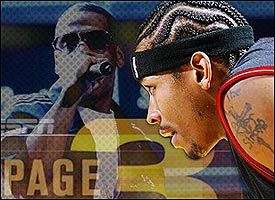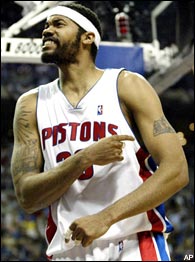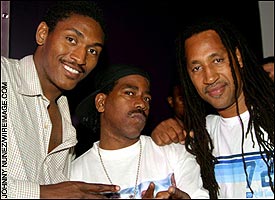| ESPN.com: Page3 |
 | |
| Players like A.I. are the living embodiment of hip-hop in a basketball uniform. |
 | |
| If you feelin' like a pimp, Jordan, go on brush your shoulders off. |
 | |
| Wallace is old skool; he brought Nike Air Force 1s back to the kicks spotlight.. |
 | |
| Pacers SF Ron Artest, left, kicks it with hip-hop pioneers Kurtis Blow and Kool Herc. |
Though there may still be many haters out there among us, it doesn't matter. hip-hop and hoops are as tight now as Halle Berry's catsuit, and that does not appear to be changing anytime soon. The connection between basketball and hip-hop may have started in the 'hood, but it has taken over the suburbs, and the style that comes from this merger also influences the many foreign players around the world now who aspire to be the next KG or the next Carmelo Anthony. Meanwhile, young black men look to hip-hop and the NBA as their way out of impoverished circumstances, and as they travel "on the road to riches and diamond rings," as Jay-Z said, they recast the American Dream in the process. In my mind, it's all good, with more to come. As Biz Markie once said, "Damn it feels good to see people up on it!" No doubt. Dr. Todd Boyd, author of "Young Black Rich and Famous: The Rise of the NBA, the hip-hop Invasion, and the Transformation of American Culture," is a Professor of Critical Studies in the USC School of Cinema-Television.